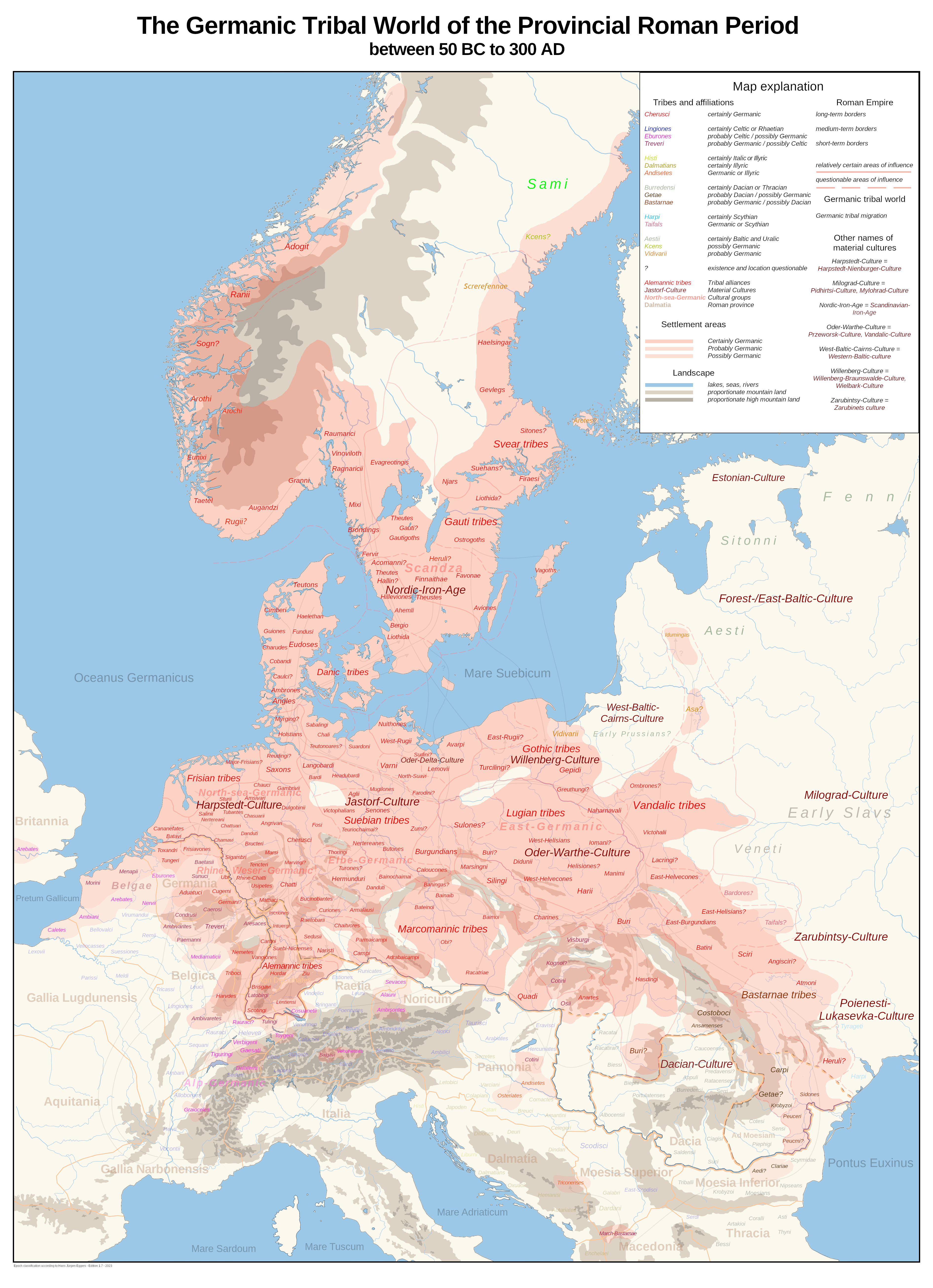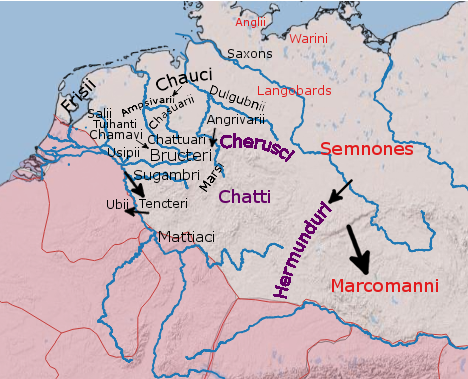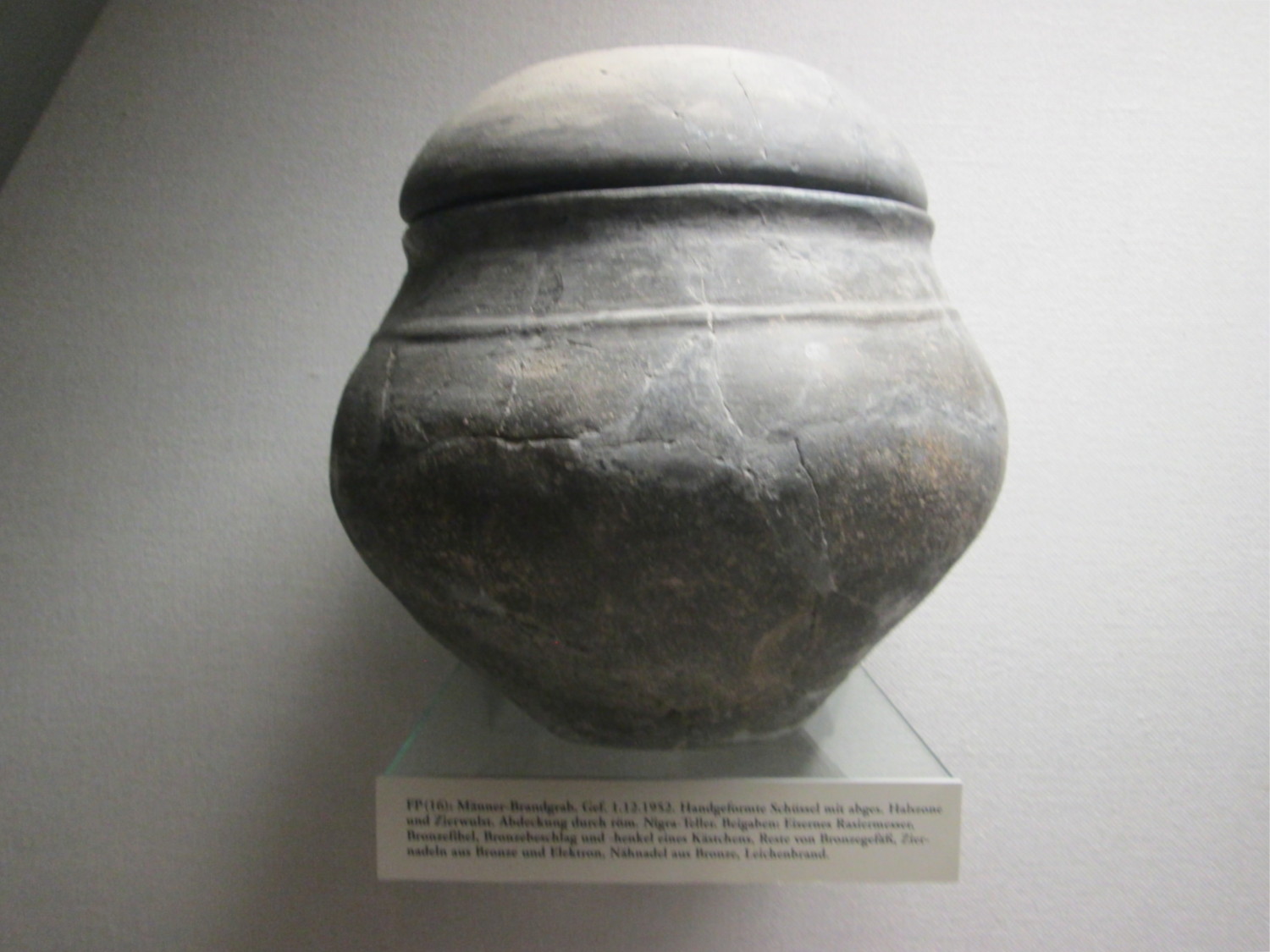|
Gambrivii
The Gambrivii were a Germanic tribe. They are first mentioned by Strabo in Geographica as the Gamabrivii. He writes that they were connected to the Chatti, the Chattuari and the Cherusci. This means that they probably lived near the Weser. The Gambrivii are also mentioned by Tacitus in Germania.Tacitus. Germania.II He counted them as among the tribes who traced their origins to the Germanic god Mannus. Along with the names of Marsi, Suevi and Vandilii the name Gambrivii is mentioned by Tacitus as one of the old and genuine names of the Germanic peoples. The Gambrivii are perhaps to be equated with the Sicambri. See also *List of Germanic peoples The list of early Germanic peoples is a catalog of ancient Germanic cultures, tribal groups, and other alliances of Germanic tribes and civilizations from antiquity. This information is derived from various ancient historical sources, beginning in ... References Sources * Max Ihm: Gambrivii. In: Paulys Realencyclopädie der cl ... [...More Info...] [...Related Items...] OR: [Wikipedia] [Google] [Baidu] [Amazon] |
List Of Germanic Peoples
The list of early Germanic peoples is a catalog of ancient Germanic cultures, tribal groups, and other alliances of Germanic tribes and civilizations from antiquity. This information is derived from various ancient historical sources, beginning in the 2nd century BC and extending into late antiquity. By the Early Middle Ages, early forms of kingship had started to shape historical developments across Europe, with the exception of Northern Europe. In Northern Europe, influences from the Vendel Period (c.AD 550- 800) and the subsequent Viking Age (c. AD 800- 1050) played a significant role in the germanic historical context. The associations and locations of the numerous peoples and groups in ancient sources are often subject to heavy uncertainty and speculation, and classifications of ethnicity regarding a common culture or a temporary alliance of heterogeneous groups are disputed. It is uncertain whether certain groups are Germanic in the broader linguistic sense or whether they c ... [...More Info...] [...Related Items...] OR: [Wikipedia] [Google] [Baidu] [Amazon] |
Sicambri
The Sicambri or Sugambri were a Germanic people who lived in the area between the Rhine, Lippe, and Wupper rivers, in what is now Germany, near the border with the Netherlands. They were first reported by Julius Caesar, who encountered them in 55 BC. They became a significant opponent of Roman imperial power in the Rhine region. After a major defeat by the Romans in 8 BC a significant part of the Sicambri were moved into Roman territory. Caesar categorized them as a Germanic people (''Germani''), although he did not necessarily define ethnicity in terms of language. Whether or not the Sicambri spoke a Germanic or Celtic language, or something else, is not certain. They lived in a contact zone where these two language families came into contact and were both influential. By the 3rd century, the region in which they and their neighbours had lived had become part of the territory of the Franks, which was a new name that possibly represented a new alliance of older tribes, possibly ... [...More Info...] [...Related Items...] OR: [Wikipedia] [Google] [Baidu] [Amazon] |
Mannus
Mannus, according to the Roman writer Tacitus, was a figure in the creation Germanic mythology, myths of the Germanic tribes. Tacitus is the only source of these myths. This is a university textbook and exists in several variants printed for different major institutions. Reprinted 2007, . Tacitus wrote that Mannus was the son of Tuisto and the progenitor of the three Germanic tribes Ingaevones, Irminones, Herminones and Istvaeones. In discussing the German tribes, Tacitus wrote: Several authors consider the name ''Mannus'' in Tacitus's work to stem from an Proto-Indo-European language, Indo-European root. The Latinized name is evidently of some relation to Proto-Germanic language, Proto-Germanic , 'man'. Mannus again became popular in literature in the 16th century, after works published by Annius de Viterbo and Johannes Aventinus purported to list him as a primeval king over Germany and Sarmatia. In the 19th century, F. Nork wrote that the names of the three sons of Man ... [...More Info...] [...Related Items...] OR: [Wikipedia] [Google] [Baidu] [Amazon] |
Chattuari
The Chattuarii, also spelled Attoarii, were a Germanic tribe of the Franks. They lived originally north of the Rhine in the area of the modern border between Germany and the Netherlands, but then moved southwards in the 4th century, as a Frankish tribe living on both sides of the Rhine. History According to Velleius Paterculus, in 4 AD, the emperor Tiberius crossed the Rhine, first attacking a tribe which commentators interpret variously as the Cananefates or Chamavi, both being in the area of the modern Netherlands, then the Chattuari, and then the Bructeri between Ems and Lippe, somewhere to the north of the modern Ruhr district in Germany. This implies that the Chattuari lived somewhere in the west of Westphalia. Strabo mentions the Chattuari as one of the non-nomadic northern Germanic tribes in a group along with the Cherusci, the Chatti, and the Gamabrivii. He also contrasted them with other non-nomadic tribes supposedly near the Ocean, the Sugambri, the "Chaubi", the Br ... [...More Info...] [...Related Items...] OR: [Wikipedia] [Google] [Baidu] [Amazon] |
Vandals
The Vandals were a Germanic people who were first reported in the written records as inhabitants of what is now Poland, during the period of the Roman Empire. Much later, in the fifth century, a group of Vandals led by kings established Vandal kingdoms first within the Iberian Peninsula, and then in the western Mediterranean islands, and North Africa. Archaeologists associate the early Vandals with the Przeworsk culture, which has led to some authors equating them to the Lugii, who were another group of Germanic peoples associated with that same archaeological culture and region. Expanding into Dacia during the Marcomannic Wars and to Pannonia during the Crisis of the Third Century, the Vandals were confined to Pannonia by the Goths around 330 AD, where they received permission to settle from Constantine the Great. Around 400, raids by the Huns from the east forced many Germanic tribes to migrate west into the territory of the Roman Empire and, fearing that they might be ... [...More Info...] [...Related Items...] OR: [Wikipedia] [Google] [Baidu] [Amazon] |
Germanic Peoples
The Germanic peoples were tribal groups who lived in Northern Europe in Classical antiquity and the Early Middle Ages. In modern scholarship, they typically include not only the Roman-era ''Germani'' who lived in both ''Germania'' and parts of the Roman Empire, but also all Germanic speaking peoples from this era, irrespective of where they lived, most notably the Goths. Another term, ancient Germans, is considered problematic by many scholars since it suggests identity with present-day Germans. Although the first Roman descriptions of ''Germani'' involved tribes west of the Rhine, their homeland of ''Germania'' was portrayed as stretching east of the Rhine, to southern Scandinavia and the Vistula in the east, and to the upper Danube in the south. Other Germanic speakers, such as the Bastarnae and Goths, lived further east in what is now Moldova and Ukraine. The term ''Germani ''is generally only used to refer to historical peoples from the 1st to 4th centuries CE. Different ac ... [...More Info...] [...Related Items...] OR: [Wikipedia] [Google] [Baidu] [Amazon] |
Suebi
file:1st century Germani.png, 300px, The approximate positions of some Germanic peoples reported by Graeco-Roman authors in the 1st century. Suebian peoples in red, and other Irminones in purple. The Suebi (also spelled Suavi, Suevi or Suebians) were a large group of Germanic peoples originally from the Elbe river region in what is now Germany and the Czech Republic. In the early Roman era they included many peoples with their own names such as the Marcomanni, Quadi, Hermunduri, Semnones, and Lombards. New groupings formed later, such as the Alamanni and Bavarians, and two kingdoms in the Migration Period were simply referred to as Suebian. Although Tacitus specified that the Suebian group was not an old tribal group itself, the Suebian peoples are associated by Pliny the Elder with the Irminones, a grouping of Germanic peoples who claimed ancestral connections. Tacitus mentions Suebian languages, and a geographical "Suevia". The Suevians were first mentioned by Julius Caesar i ... [...More Info...] [...Related Items...] OR: [Wikipedia] [Google] [Baidu] [Amazon] |
Marsi (Germanic)
The Marsi () were a small Germanic tribe settled between the Rhine, Ruhr and Lippe rivers in northwest Germany. It has been suggested that they were a part of the Sugambri who managed to stay east of the Rhine after most Sugambri had been moved from this area. Strabo describes the Marsi as an example of a Germanic tribe who were originally from the Rhine area, now the war-torn Roman frontier, but had migrated deep into Germania. History Tacitus mentions them repeatedly, in particular in the context of the wars of Germanicus. They had been part of the tribal coalition of the Cheruscian war leader and traitor to Rome, Arminius that in 9 AD annihilated three Roman legions under Varus in the Battle of Teutoburg Forest. Germanicus, seeking revenge for this defeat, invaded the lands of the Marsi in 14 AD with 12,000 legionnaires, 26 cohorts of auxiliaries and eight cavalry squadrons. The Marsi were massacred during a festival near a temple dedicated to Tamfana. According to Tac ... [...More Info...] [...Related Items...] OR: [Wikipedia] [Google] [Baidu] [Amazon] |
Germania (Church & Brodribb)
Germania ( ; ), also more specifically called Magna Germania (English: ''Great Germania''), Germania Libera (English: ''Free Germania''), or Germanic Barbaricum to distinguish it from the Roman provinces of Germania Inferior and Germania Superior, was a historical region in north-central Europe during the Roman era, which was associated by Roman authors with the Germanic peoples. According to Roman geographers, this region stretched roughly from the Rhine in the west to the Vistula in the east, and to the Upper Danube in the south, and the known parts of southern Scandinavia in the north. Archaeologically, these people correspond roughly to the Roman Iron Age of those regions. The Latin name ''Germania'' means "land of the Germani", but the etymology of the name ''Germani'' itself is uncertain. During the Gallic Wars of the 1st century BC, the Roman general Julius Caesar encountered ''Germani'' originating from beyond the Rhine. He referred to their lands beyond the Rhine as "G ... [...More Info...] [...Related Items...] OR: [Wikipedia] [Google] [Baidu] [Amazon] |
Strabo
Strabo''Strabo'' (meaning "squinty", as in strabismus) was a term employed by the Romans for anyone whose eyes were distorted or deformed. The father of Pompey was called "Gnaeus Pompeius Strabo, Pompeius Strabo". A native of Sicily so clear-sighted that he could see things at great distance as if they were nearby was also called "Strabo". (; ''Strábōn''; 64 or 63 BC) was an ancient Greece, ancient Greek geographer who lived in Anatolia, Asia Minor during the transitional period of the Roman Republic into the Roman Empire. He is best known for his work ''Geographica'', which presented a descriptive history of people and places from different regions of the world known during his lifetime. Additionally, Strabo authored historical works, but only fragments and quotations of these survive in the writings of other authors. Early life Strabo was born to an affluent family from Amasya, Amaseia in Kingdom of Pontus, Pontus in around 64BC. His family had been involved in politics s ... [...More Info...] [...Related Items...] OR: [Wikipedia] [Google] [Baidu] [Amazon] |
Germania (book)
The ''Germania'', written by the Roman historian Publius Cornelius Tacitus around 98 AD and originally titled ''On the Origin and Situation of the Germans'' (), is a historical and ethnographic work on the Germanic peoples outside the Roman Empire. Contents The ''Germania'' begins with a description of the lands, laws, and customs of the Germanic people (chapters 1–27); it then describes individual peoples, beginning with those dwelling closest to Roman lands and ending on the uttermost shores of the Baltic, among the amber-gathering Aesti, the Fenni, and the unknown peoples beyond them. Tacitus says (chapter 2) that physically, the Germanic peoples appear to be a distinct nation, not an admixture of their neighbors, since nobody would desire to migrate to a climate as horrid as that of Germania. They are divided into three large branches, the Ingaevones, the Irminones, and the Istaevones, deriving their ancestry from three sons of Mannus, son of Tuisto, their comm ... [...More Info...] [...Related Items...] OR: [Wikipedia] [Google] [Baidu] [Amazon] |






